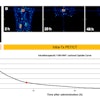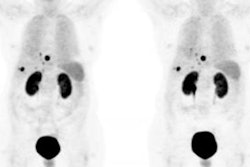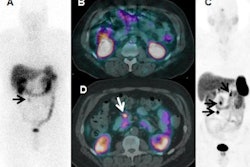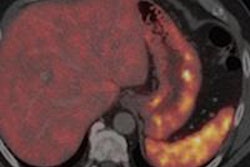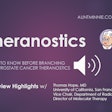PET/CT scans with the radiotracer gallium-68 (Ga-68) DOTA-NOC are "highly sensitive and specific" for detecting gastroenteropancreatic neuroendocrine tumors, outperforming conventional imaging such as CT, ultrasound, and MRI, according to a study published in the November issue of the American Journal of Roentgenology.
The research, led by Dr. Niraj Naswa from the department of nuclear medicine at All India Institute of Medical Sciences, also found that the information gleaned from Ga-68 DOTA-NOC-PET/CT can significantly affect patient treatment for the neuroendocrine tumors (AJR, Vol. 197:5, pp. 1221-1228).
Gallium-68 DOTA-NOC binds to somatostatin receptors, which are found on the surface of neuroendocrine tumors. By injecting the tracer into patients, PET/CT scans can be used to visualize the tumors.
CT, ultrasound, and MRI historically have been used to diagnose gastroenteropancreatic neuroendocrine tumors, with MRI being the most sensitive for detecting liver metastases, which can be difficult to localize because of their small size, the authors noted.
Subjects and methods
The prospective study enrolled 109 patients with gastroenteropancreatic neuroendocrine tumors who were evaluated with Ga-68 DOTA-NOC-PET/CT between October 2007 and September 2010. The researchers included only the initial PET/CT studies -- not any follow-up exams -- in their analysis.
The results were analyzed based on staging the disease in patients with confirmed neuroendocrine tumors, detecting recurrence in patients who had been treated for neuroendocrine tumors, and diagnosing neuroendocrine tumors in patients suspected of having the disease.
Naswa and colleagues also sought to compare PET/CT results with conventional imaging modalities to determine whether the results of Ga-68 DOTA-NOC-PET/CT would alter patient treatment plans.
The scans were performed on a dedicated PET/CT scanner (Biograph, Siemens Healthcare), with an injected dose of 132 MBq to 222 MBq of Ga-68 DOTA-NOC. PET/CT scans were performed after a 45- to 60-minute uptake period.
Two experienced nuclear medicine physicians evaluated the DOTA-NOC-PET/CT images and were blinded to the findings of structural imaging. Positive findings on the scans were localized to anatomic images from the unenhanced CT portion of the scan. The criterion for correct detection was both positive DOTA-NOC uptake and the correct anatomic localization of the tumor.
Primary tumor results
A review of the images found that DOTA-NOC-PET/CT detected primary tumors in 57 (79%) of 72 patients, with a total of 67 primary tumors localized in the 57 patients. The most common site of primary tumor was the pancreas. PET/CT was unable to localize primary tumors in the remaining 15 patients.
The overall sensitivity, specificity, positive predictive value, negative predictive value, and accuracy of DOTA-NOC-PET/CT for primary tumors was equal to or surpassed that of conventional imaging in all five evaluations.
|
|||||||||||||||||||||||||||||||||||||||
DOTA-NOC-PET/CT findings established true positives for primary tumors in 54 patients and true negatives in 37. Three patients had false positives and 15 had false negatives.
The scans localized primary tumors in 18 patients with carcinoid, 15 patients with gastrinoma, four patients with insulinoma, and 17 patients with neuroendocrine tumors not otherwise specified.
Metastases results
DOTA-NOC-PET/CT also was able to detect metastases in 75 (97%) of 77 patients with one or more sites of metastases, with the hybrid modality finding a total of 106 metastatic regions among the 75 patients. The most common site of metastases was the liver, followed by the lymph nodes.
Once again, DOTA-NOC-PET/CT achieved sensitivity, specificity, positive predictive value, negative predictive value, and accuracy equal to or greater than that of conventional imaging. There were true-negative results in 32 patients and no cases of false-positive lesions. Two patients had false-negative results for liver metastases.
Naswa and colleagues also found that there was a "substantial change" in treatment for 21 patients (19%), whereas DOTA-NOC-PET/CT supported treatment decisions in 32 patients (29%).
Six patients (5%) underwent surgery for primary lesions that were not discovered by conventional imaging, including two patients who underwent resection for a primary tumor, and resection for an insulinoma, a glucagonoma, and a gastrinoma that were not seen by other modalities. DOTA-NOC-PET/CT helped determine the proper surgical plans for eight patients.
For five of the eight patients, the additional information provided by PET/CT led to the removal of more primary foci for a complete surgical cure. Additional nodal disease was detected in two patients who underwent complete excisions, while four patients were spared unnecessary surgery because the scans found an advanced stage of the disease.
DOTA-NOC-PET/CT "appears to be a highly sensitive and specific modality in the detection of gastroenteropancreatic neuroendocrine tumors," Naswa and colleagues concluded. "It is better than conventional imaging for this patient population and can have significant impact on patient management."
In addition, a negative finding on DOTA-NOC-PET/CT "can guide the treating physician to choose an alternate form of treatment," they wrote.



